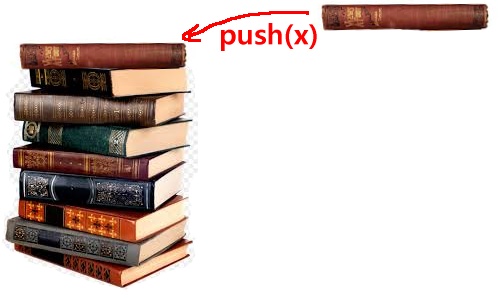Review: the
stack data structure
- A stack
data structure is
like a stack of
books:

|
Review: the
stack data structure
- The push operation
will "insert"/add
an item on
top of the
stack:

|
Review: the
stack data structure
Review:
our Stack interface
definition
- Our
Stack interface
definition:
interface MyStack<E>
{
public boolean isEmpty(); // returns true is stack is empty
public boolean isFull(); // returns true is stack is full
public void push(E e); // Pushes elem e on the stack
public E pop(); // Remove the elem at the top
// of the stack and return it
public E peek(); // Return the elem at the top
// without removing it
}
|
|
Review: implementing the
stack
using an array
- Implementing
a Stack
with an array:
- Each
array element
stores one data item
of the
stack
- A
stackTop index variable
to record the
first open position
in
the array
|
Schematically:

- Resizing
the array:
- Double the
array size when the
stack is
full
(need
to
copy)
- Half the
array size when
occupancy level < 25%
|
|
Implementing the stack using a
linked list
Implementing the
push() and
pop()
operation
- The push(item) operation
is equivalent to
addFirst(item):
(I.e.:
insert at the
front of the
list):

- The pop() operation
is equivalent to
removeFirst():
(I.e.:
remove from the
front of the
list):

|
Implementing the
MyStack interface
with the
ListStack class
- Let's write a
ListStack class
that implements our
MyStack interface:
public class ListStack<T> implements MyStack<T>
{
private class Node<T>
{
private T item;
private Node<T> next;
public Node(T item, Node<T> next)
{
this.item = item;
this.next = next;
}
public String toString(){ return "" + this.item; }
} // End of private inner class "Node"
private Node<T> first;
public ListStack() // Constructs an empty list/stack
{
first = null; // Empty list ≡ empty stack
}
public boolean isEmpty() { ... } // returns true is stack is empty
public boolean isFull() { ... } // returns true is stack is full
public void push(E e) { ... } // Pushes elem e on the stack
public E pop() { ... } // Remove and return the elem at the top
public E peek() { ... } // Return the elem at the top
}
|
|
Implementing the
MyStack interface
with the
ListStack class
-
isEmpty()
tests
whether the
list is empty and
isFull() will
always return false:
public class ListStack<T> implements MyStack<T>
{
private class Node<T>
{
... body omitted for brevity
} // End of private inner class "Node"
private Node<T> first;
public ListStack() // Constructs an empty list/stack
{
first = null; // Empty list ≡ empty stack
}
public boolean isEmpty() // returns true is stack is empty
{
return first == null ;
}
public boolean isFull() // returns true is stack is full
{
return false; // Because a linked list is not fixed size
}
... other stack methods omitted for brevity
}
|
|
Implementing the
MyStack interface
with the
ListStack class
-
push(item)
is the
same as
addFirst(item):
public class ListStack<T> implements MyStack<T>
{
private class Node<T>
{
... omitted for brevity
} // End of private inner class "Node"
private Node<T> first;
public ListStack() // Constructs an empty list/stack
{
first = null; // Empty list ≡ empty stack
}
// push(item) --> insert at the front of the list
public void push(T item)
{
Node<T> newNode = new Node<T>(item, first);
first = newNode;
}
... other stack methods omitted for brevity
}
|
|
Implementing the
MyStack interface
with the
ListStack class
-
pop()
is the
same as
removeFirst(item):
public class ListStack<T> implements MyStack<T>
{
private class Node<T>
{
... omitted for brevity
} // End of private inner class "Node"
private Node<T> first;
public ListStack() // Constructs an empty list/stack
{
first = null; // Empty list ≡ empty stack
}
// pop() --> remove the first item and return it
public T pop( )
{
if( isEmpty() )
{
throw new NoSuchElementException();
}
T toReturn = first.item; // Save return item
first = first.next; // Unlink the first node
return toReturn;
}
... other stack methods omitted for brevity
}
|
|
Implementing the
MyStack interface
with the
ListStack class
-
peek()
is
similar to
removeFirst(item),
except we
do not
remove the
first node:
public class ListStack<T> implements MyStack<T>
{
private class Node<T>
{
... omitted for brevity
} // End of private inner class "Node"
private Node<T> first;
public ListStack() // Constructs an empty list/stack
{
first = null; // Empty list ≡ empty stack
}
// pop() --> return the first item
public T pop( )
{
if( isEmpty() )
{
throw new NoSuchElementException();
}
return first.item; // return item
}
... other stack methods omitted for brevity
}
|
|
SHOW:
11-linked-list/10-stack-with-list/ListStack.java
Properties of the
stack implementation using
a linked list
- The push( ) and
pop( )
does not have
any
loops
We
say that:
- The push( ) and
pop( )
runs in
constant time
|
- There is
no need to
resize
the
linked list !!
|
How to define an
stack of Integer
with the
generic
ListStack
- We can create a
stack of Integer by
using
Integer as
parameter when
defining
a generic ListStack
variable:
public static void main(String[] args)
{
ListStack<Integer> s = new ListStack<>(5);
s.push(1);
s.push(2);
s.push(3);
s.push(4);
System.out.println( s );
System.out.println( s.pop() );
System.out.println( s );
System.out.println( s.pop() );
System.out.println( s );
System.out.println( s.pop() );
System.out.println( s );
System.out.println( s.pop() );
System.out.println( s );
}
|
|
DEMO:
demo/11-linked-list/10-stack-with-list/Demo.java
How to define an
stack of String
with the generic stack
- We can create a
stack of String by
using
String as
parameter when
defining
a generic ListStack
variable:
public static void main(String[] args)
{
ListStack<String> s = new ListStack<>(5);
s.push("not");
s.push("or");
s.push("be");
s.push("to");
System.out.println( s );
System.out.println( s.pop() );
System.out.println( s );
System.out.println( s.pop() );
System.out.println( s );
System.out.println( s.pop() );
System.out.println( s );
System.out.println( s.pop() );
System.out.println( s );
}
|
|
DEMO:
demo/11-linked-list/10-stack-with-list/Demo2.java
Postscript: another way to
implement a stack with a linked list
- We can also
implement a
stack using:
- push(item)
≡
addLast(item)
- pop( )
≡
removeLast( )
|
However:
- Why ???
|
Postscript: another way to
implement a stack with a linked list
- We can also
implement a
stack using:
- push(item)
≡
addLast(item)
- pop( )
≡
removeLast( )
|
However:
- Answer:
- addLast() and
removeLast()
requires the
use of the
list traversal
algorithm and will runs
slower !!!
|
|
❮
❯